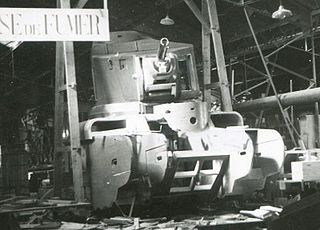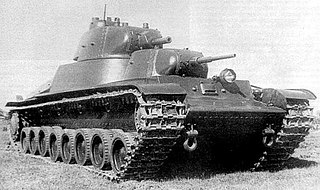 W
WThe 7TP was a Polish light tank of the Second World War. It was developed from the British Vickers 6-ton. A standard tank of the Polish Army during the 1939 Invasion of Poland, its production did not exceed 150 vehicles. Its chassis was used as the base for the C7P artillery tractor.
 W
WThe "ARL tracteur C", or ARL Char C, was a French super-heavy tank developed during the late Interbellum by the Atelier de Construction de Rueil (ARL) company. A full-scale wooden mockup was halfly produced, but the project was terminated in favor of FCM F1, a directly competing design, which proved to be superior design. The vehicle was meant to be extremely heavy and for that time period, very heavily armored. ARL C was intended to be very long to fill up the requirement of having a long tank that could cross trenches up to 7 meters wide. The tank was multi-turreted like FCM F1; however, unlike FCM F1, ARL C had the main turret in front of the very long hull right behind the secondary turret, not in the back of vehicle. The development path of the ARL C was extremely complex, due to the existence of a number of parallel super-heavy tank projects with overlapping design goals, the specifications of which were regularly changed. For each project in turn several companies submitted one or more competing proposals.
 W
WThe Char 2C, also known as the FCM 2C, is a French heavy tank, later also seen as a super-heavy tank, developed during World War I but not deployed until after the war. It was, in physical dimensions, the largest operational tank ever made.
 W
WThe Tank, Cruiser, Mk I (A9) was a British cruiser tank of the interwar period. It was the first cruiser tank: a fast tank designed to bypass the main enemy lines and engage the enemy's lines of communication, along with enemy tanks. The Cruiser Mk II was a more heavily armoured adaptation of the Mark I, developed at much the same time.
 W
WThe A.15 Tank, Cruiser, Mk VI or Crusader was one of the primary British cruiser tanks during the early part of the Second World War. Over 5,000 tanks were manufactured and they made important contributions to the British victories during the North African Campaign. The Crusader tank would not see active service beyond Africa, but the chassis of the tank was modified to create anti-aircraft, fire support, observation, communication, bulldozer and recovery vehicle variants.
 W
WThe M2 light tank, officially Light Tank, M2, was an American pre–World War II light tank which saw limited use during World War II. The most common model, the M2A4, was equipped with one 37 mm (1.5 in) M5 gun and five .30 cal M1919 Browning machine guns.
 W
WThe Medium Mark III was a medium tank developed in the United Kingdom during the Interwar period. The tank was unsuccessful with only 3 built. The design did not directly derive from that of the earlier Medium Mark II tank.
 W
WThe German Neubaufahrzeug series of tank prototypes were a first attempt to create a medium tank for the Wehrmacht after Adolf Hitler had come to power. Multi-turreted, heavy and slow, they were not considered successful, which led to only five being produced. These were primarily used for propaganda purposes and training, though three took part in the Battle of Norway in 1940.
 W
WThe SMK was an armored vehicle prototype developed by the Soviet Union prior to the Second World War. It was named after Sergei Mironovich Kirov, a Communist Party official assassinated in 1934. The SMK was discovered and classified by German intelligence as the T-35C, leading to the misunderstanding that the T-35 took part in the Winter War.
 W
WThe T-24 was a Soviet medium tank built in 1931. Only twenty four were built, and none saw combat. This was the first tank produced at the KhPZ factory in Kharkov, which was later responsible for the very successful BT series, T-34 and T-54 Soviet tanks. The T-24's suspension was used successfully in the Soviet Union's first purpose-built artillery tractors.
 W
WThe T-26 tank was a Soviet light infantry tank used during many conflicts of the Interwar period and in World War II. It was a development of the British Vickers 6-Ton tank and was one of the most successful tank designs of the 1930s until its light armour became vulnerable to newer anti-tank guns. It was produced in greater numbers than any other tank of the period, with more than 11,000 units manufactured. During the 1930s, the USSR developed 53 variants of the T-26, including flame-throwing tanks, combat engineer vehicles, remotely controlled tanks, self-propelled guns, artillery tractors, and armoured carriers. Twenty-three of these were series-produced, others were experimental models.
 W
WThe T-28 was a Soviet multi-turreted medium tank. The prototype was completed in 1931, and production began in late 1932. It was an infantry support tank intended to break through fortified defences. The T-28 was designed to complement the heavier T-35, with which it shared turret designs. The type did not have great success in combat, but it played an important role as a development project for Soviet tank designers. A series of new ideas and solutions that were tried out on the T-28 were later incorporated in future models.
 W
WThe T-35 was a Soviet multi-turreted heavy tank of the interwar period and early Second World War that saw limited production and service with the Red Army. Often called a land battleship, it was the only five-turreted heavy tank in the world to reach production, but proved to be slow and mechanically unreliable. Most of the T-35 tanks still operational at the time of Operation Barbarossa were lost due to mechanical failure rather than enemy action. It was designed to replace the T-28 at the time, however, very few were built.
 W
WThe T-100 was a Soviet twin-turreted heavy tank prototype, designed in 1938–39 as a possible replacement for the T-35. The T-100 was designed by N. Barykov's OKMO design team at S.M. Kirov Factory No. 185 in Leningrad. The T-100 was originally conceived with three turrets and was eventually built with two. It was in competition with a similar design - the SMK - but neither were adopted and instead a single turret version on the SMK was ordered as the KV-1. All three prototypes were tested at the same time in the Battle of Summa.
 W
WThe Type 95 Heavy Tank was the final result of Japanese multi-turreted tank design, and was in commission during the time period between World War I and World War II. Modeled on German and Italian tank designs, this tank featured 3 turrets. The main armament being a 70 mm cannon in a central turret, with its secondary front turret mounting a 37 mm gun and a 6.5 mm machine gun in the rear turret. Four prototypes were produced in 1934.
 W
WThe Vickers 6-Ton Tank or Vickers Mark E was a British light tank designed as a private project at Vickers. It was not purchased by the British Army, but was picked up by many foreign armed forces. It was licensed by the Soviets as the T-26. It was also the direct predecessor of the Polish 7TP tank.
 W
WThe Independent A1E1 is a multi-turreted tank that was designed by the British armaments manufacturer Vickers between the First and Second World Wars. Although it only ever reached the prototype stage and only a single example was built, it influenced many other tank designs.